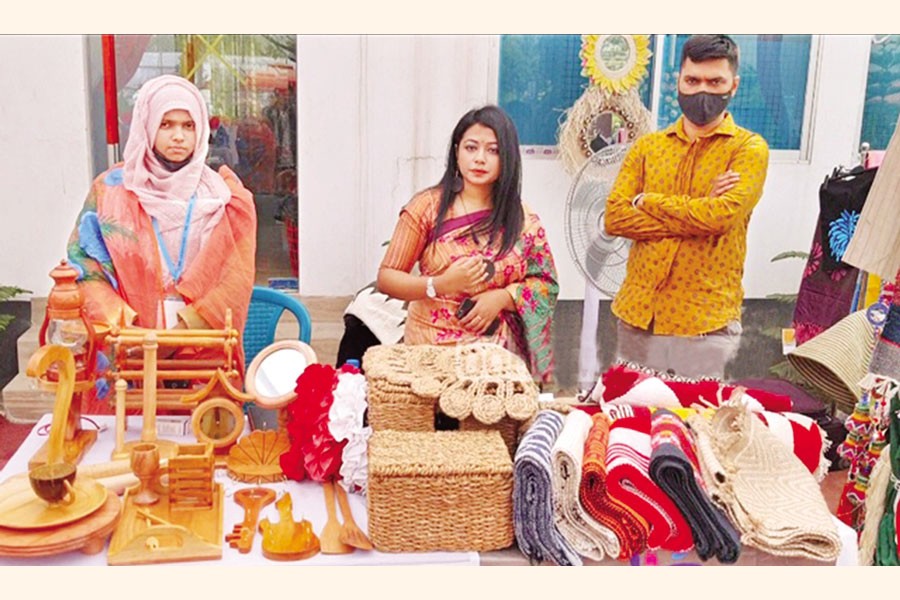
Of lifting our women from the sticky floors...
Avinno Faruk | Wednesday, 8 December 2021

 Much of the familiar discussion on women's empowerment focuses on the glass ceiling effect - the invisible barrier that women face in reaching leadership positions. Yet research shows that the sticky floor effect is more pertinent to developing countries, and Bangladesh is no different. In simple terms, the situation where women remain trapped in lower-paying jobs or lower-position encapsulates the "sticky floor" effect.
Much of the familiar discussion on women's empowerment focuses on the glass ceiling effect - the invisible barrier that women face in reaching leadership positions. Yet research shows that the sticky floor effect is more pertinent to developing countries, and Bangladesh is no different. In simple terms, the situation where women remain trapped in lower-paying jobs or lower-position encapsulates the "sticky floor" effect.
Our female labour force participation (FLFP) rate was increasing consistently before Covid-19, though there were concerns regarding its stagnation, with the rate hovering around 36 per cent since 2010 to 2016-17. The next round of Labour Force Survey (LFS) data is yet to be available - a national survey that measures labour market statistics every three or four years - but it is anticipated that the pandemic may undo some of the achievements made in the past. Setting aside the probable impact of the pandemic, the quality of FLFP in Bangladesh, in general, is a cause of concern.
According to the LFS 2016-17, about one-tenth of all employed individuals are contributing family workers, who are typically unpaid. And, this is the only category of employment where women are overrepresented: thrice as many women compared to men. On the other hand, women are largely absent in senior and middle management roles, occupying only 10 per cent positions. The readymade garments (RMG) sector, much lauded for creating women's formal employment, has only about 9.0 per cent women in managerial and supervisory roles, and this has changed little over time, according to a report by ILO (2020). So, what could be done to lift women from the sticky floor situation? Though it is a complex issue and it needs extensive research, a few solutions are apparent, which are discussed below:
Promoting women in STEM: How many of us have grown up hearing that engineering degrees are not meant for girls? Perhaps many, because only around 30 per cent of students enrolled in engineering and technological public universities were women in 2019, as per UGC. Such disparities stem from and reinforce the notions that women are not suitable for these degrees. For instance, according to UNESCO, only 14 per cent of researchers in science are women in Bangladesh.
To thrive in the era of the Fourth Industrial Revolution-defined by the supremacy of science and technology-Bangladesh must focus on providing high-quality STEM (science, technology, engineering, and mathematic) education to the young people. Thus, in society where women are discouraged to pursue an education in STEM, the sticky floor effect on women's employment may worsen in future. The effect has possibly already started to emerge. For instance, the 2020 ILO report says when RMG factories upgrade technology, the share of women workers in production segments falls.
While scholarships aimed at women in STEM can be a way out, the problem is not so simple. Bangladesh has one of the highest rates of child marriage, and a typical Bangladeshi woman, if not married before turning 18, is bound to face the social pressures of getting married when they are in the age-bracket for higher studies. Thus, the problem is also one of ensuring that girls can continue higher education and opt for STEM degrees. Additionally, it would be even more beneficial if the curriculum's are designed keeping the demands of the evolving industries in mind.
Providing daycare centres and parental leaves: Motherhood penalty is one of the primary reasons women tend to not take up mid- or senior-level positions. Unfortunately mothers in Bangladesh still continue to bear the care burden. They do not take higher level positions that come with greater responsibility after having children, or even leave present jobs altogether, which is frequently identified as women's own preferences, whereas in fact this is a choice under constraints: most workplaces do not provide adequate daycare facilities. Moreover, while laws exist for maternity leaves, they are not always enforced properly, and ultimately do not translate into real benefits for women. While women must be granted their lawful maternity leave, the government must introduce paternity leave. This will not only be beneficial for the child, but also start instilling the notion that childcare is a shared responsibility of both parents.
Enhancing soft skills and financial literacy: Recently, the Asia Girls' Leadership Index 2021 ranked Bangladesh 16 the out of 19 countries, which is alarming. Managerial or leadership role requires many soft and practical skills, besides the curriculum-based educational qualifications. The ILO report highlighted the confidence deficiencies among low-skilled women to take up higher level positions because they do not have these competencies. Emotional intelligence, basic financial education, negotiation and communication skills, etc. can all be part of leadership programmes for women to help them climb the professional ladder.
Changing perceptions: A 2020 study by Macchiavello finds that despite the absence of evidence of any skill gap, women's managerial capabilities are often underestimated by RMG factory workers, which leads to their underperformance. Once these employees are exposed to female supervisors, they tend to update their beliefs and such resistance from the subordinates, especially male workers wanes. The researchers of the study recommended financial incentives to firms from the government to promote women to supervisory roles so that the biases against them can be overcome.
But this is not enough. Perceptions are often hardwired at young age, and thus need to be addressed earlier. A study by Asadullah, Islam and Wahhaj (2018), found Bangladeshi textbooks to feature severe gender stereotypes and few women in lead roles. Most were also authored by men. If such gender imbalances are imprinted on young minds, it will be harder to fight these conscious or subconscious biases later when they become our friends, co-workers or spouses.
Ensuring safety and security: One of the main barriers of greater mobility among women and girls is the associated security concern. It is crucial to ensure safety both within and outside workplaces, for instance, by providing office transport for safe commute and having well-designed harassment policies in place. These are some of the strategies that organisations themselves can take, with support from the government. When asked about why the senior levels in RMG factories are so male-dominated, women workers cited that men were able to work in late hours while men responded to less security issues faced by them as some of the reasons (ILO, 2020).
These are only a handful of things that can be done. It is also important to look at them as interlinked aspects, and not treated on their own. A collective and pro-active approach from the government, academics, and industry and development organisations is needed to help women leave the sticky floor and pursue better employment opportunities.
The writer is working as a research associate at BRAC Institute of Governance and Development (BIGD), BRAC University.
avinno.faruk@bracu.ac.bd